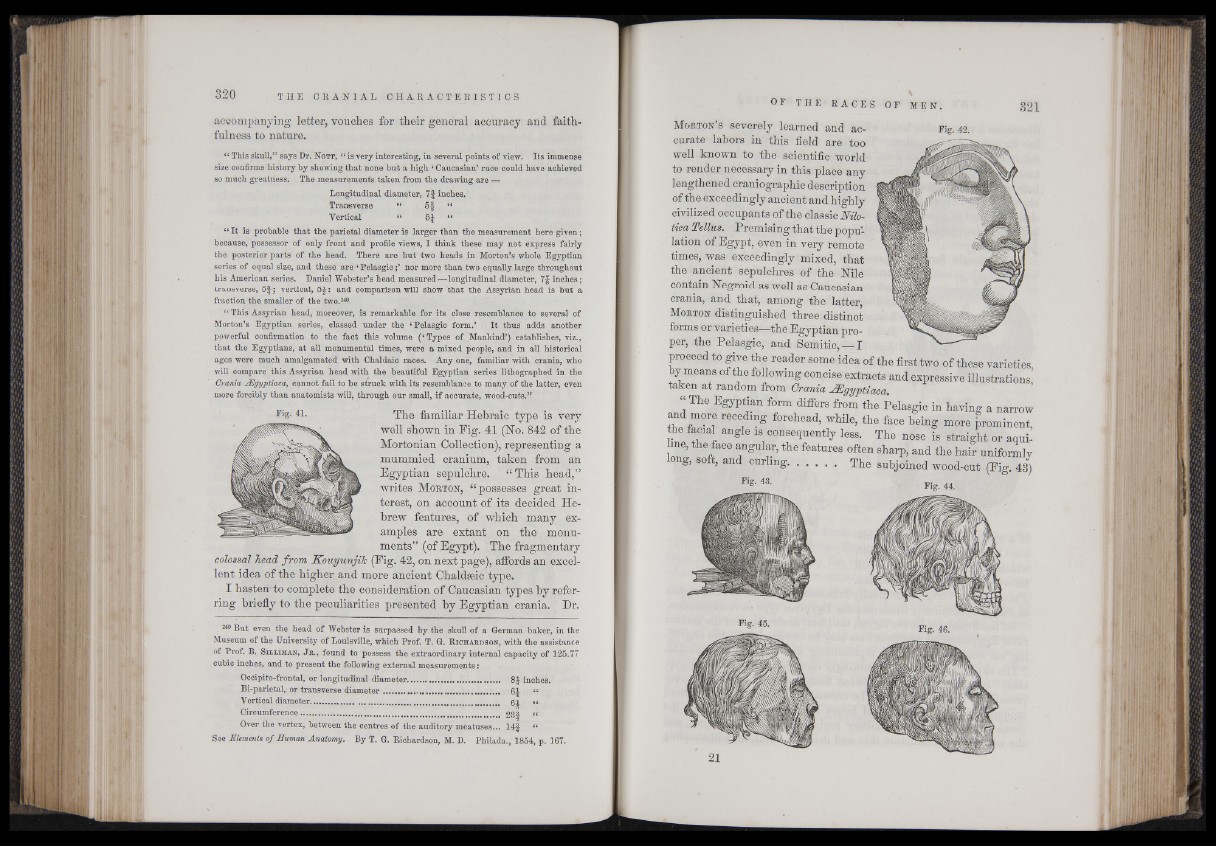
accompanying letter, vouches for their general accuracy and faithfulness
to nature.
“ This skull,” says Dr. N o tt , “ is very interesting, in several points of view. Its immense
size confirms history by showing that none but a high | Caucasian’ race could have achieved
so much greatness. The measurements taken from the drawing are —-
Longitudinal diameter, 7 f inches.
Transverse “ 5§ “
Vertical “ 5J “
“ It is probable that the parietal diameter is larger than the measurement here given;
because, possessor of only front and profile views, I think these may not express fairly
the posterior parts of the head. There are but two heads in Morton’s whole Egyptian
series of equal size, and these are ‘Pelasgic;’ nor more than two equally large throughout
his American series. Daniel Webster’s head measured—longitudinal diameter, 7J inches;
transverse, 5 § ; vertical, 5£: and comparison will show that the Assyrian head is but a
fraction the smaller of the two.240-
“ This Assyrian head, moreover, is remarkable for its close resemblance to several of
Morton’s Egyptian series, classed under the ‘Pelasgic form.’ | It thus adds another
powerful confirmation to the fact this volume (‘Types of Mankind’) establishes, viz.,
that the Egyptians, at all monumental times, were a mixed people, and in all historical
ages were much amalgamated with Chaldaic races. Any one, familiar with crania, who
will compare this Assyrian head with the beautiful Egyptian series lithographed in the
Crania 2Egyptiaca, cannot fail to be struck with its resemblance to many of the latter, even
more forcibly than anatomists will, through our small, if accurate, wood-cuts.”
Fis- 41- The familiar Hebraic type is very
well shown in Fig. 41 (Ho. 842 of the
Mortonian Collection), representing a
mummied cranium, taken from an
Egyptian sepulchre. “ This head,”
writes M orton, “ possesses great interest,
on account of its decided Hebrew
features, of which many examples
are extant on the monuments”
(of Egypt). The fragmentary
colossal head from Kowyunjilc (Fig. 42, on next page), affords an excellent
idea of the higher and more ancient Chaldseic type.
I hasten to complete the consideration of Caucasian types by referring
briefly to the peculiarities presented by Egyptian crania. Dr.
240 But even the head of Webster is surpassed by the skull of a German baker, in the
Museum of the University of Louisville, which Prof. T. G. R ic h a r d s o n , with the assistance
of Prof. B. S il l im a n , J r ., found to possess the extraordinary internal capacity of 125.77
cubic inches, and to present the following external measurements:
Occipito-frontal, or longitudinal diameter................................. ....... 8 J- inches.
Bi-parietal, or transverse diameter.............. 6J “
Vertical diameter....... m................... gi <<
Circumference................ g| 233. «
Over the vertex, between the centres of the auditory meatuses... 14|- “
See Elements of Human Anatomy. By T. G. Richardson, M. D. Philada., 1854, p. 167.
M o r t o n ’s severely learned and ac- Fig. 42.
curate labors in this field are too
well known to the scientific world
to render necessary in this place any
lengthened eraniographic description
of the exceedingly ancient and highly
civilized occupants of the classic Nilo-
tica Tellus. Premising that the population
of Egypt, even in very remote
times, was exceedingly mixed, that
the ancient sepulchres of the Nile
contain Negroid as well as Caucasian
crania, and that, among the latter,
M orton distinguished three distinct
forms or varieties-—the Egyptian proper,
the Pelasgic, and Semitic, — I
proceed to give the reader some idea of the first two of these varieties,
by means of the following concise extracts and expressive illustrations,
taken at random from Crania Ægyptiaca.
I The Egyptian form differs from the Pelasgic in having a narrow
and more receding forehead, while, the face being more prominent,
the facial angle is consequently less. The nose is straight or aqui-
me, the face angular, the features often sharp, and the hair uniformly
long, soft, and curling................ The subjoined wood-cut (Fig. 43)
Fig. 43. Fig. 44.
Fig. 45. Fig. 46.